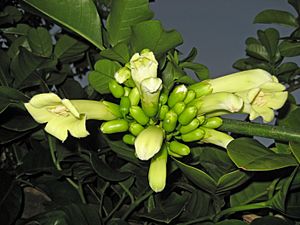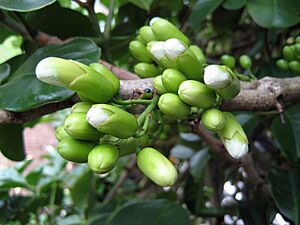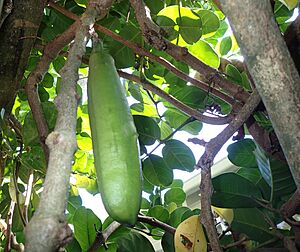Tecomanthe speciosa facts for kids
Quick facts for kids Tecomanthe speciosa |
|
|---|---|
 |
|
| Conservation status | |
 Nationally Critical (NZ TCS) |
|
| Scientific classification | |
| Genus: |
Tecomanthe
|
| Species: |
speciosa
|
The Tecomanthe speciosa, also known as the Three Kings vine or akapukaea, is a very special plant. Only one single plant of this kind was ever found growing in the wild! It was discovered on the Manawatāwhi / Three Kings Islands, which are about 55 kilometers off the northern tip of New Zealand. This amazing discovery happened during a science trip in 1945. No other wild plants of this species have ever been found since then. The Tecomanthe group of plants usually grows in tropical places, so finding one in New Zealand was quite a surprise! Other plants from this group can be found in places like Queensland, Indonesia, New Guinea, and the Solomon Islands.
What Does the Three Kings Vine Look Like?
The Three Kings vine is a strong climbing plant that can grow up to 10 meters tall. It has shiny, thick leaves made up of five smaller parts. In autumn or early winter, it grows long, creamy white, tube-shaped flowers. These flowers grow right from the plant's stems in big groups.
Scientists think these flowers might have once been pollinated by bats. Even though bats don't live on the Three Kings Islands anymore, they might have in the past. Today, many native and other birds help pollinate the flowers of plants grown by people.
How This Plant Was Saved
Even though the Three Kings vine might have been common a long time ago, by 1945, there was only one plant left. This happened because goats were brought to the islands. These goats ate almost all the plants. Luckily, the last remaining Three Kings vine was growing on a cliff that was too steep for the goats to reach.
Horticulturists, who are experts in growing plants, saved it! They took small pieces (cuttings) from the original plant to grow new ones. After that, all the goats were removed from the island. The original plant is still growing in the wild today. It has even grown more vines on its own over the years.
This plant is considered "Nationally Critical" in New Zealand. This means it's one of the most endangered plants in the world.
Growing the Three Kings Vine
After about ten years, the plants grown by the horticulturists finally produced seeds. Since then, the Three Kings vine has become popular in New Zealand gardens. People like it because it's a strong climber and looks like a tropical plant.
This plant needs warm weather. It can be easily damaged by frost if the temperature drops below -2 degrees Celsius. You can grow new plants from cuttings, by layering (where a branch grows roots while still attached to the main plant), or from seeds.
If you plant fresh seeds, they should sprout within two weeks. The young plants grow quickly and might even flower in two or three years. Plants grown from cuttings might take a bit longer, sometimes up to five years or more, to produce flowers.




